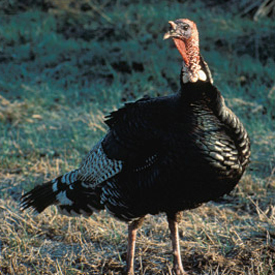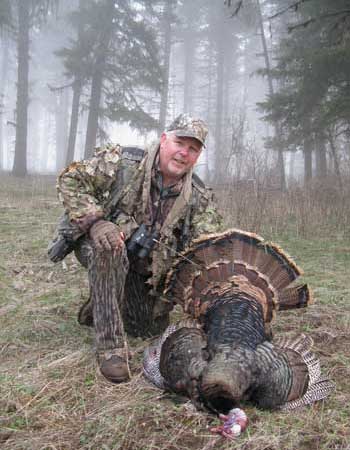Turkey Hunting Safety

Set Your Sights on Safety
Wild turkey hunting can be one of the most rewarding challenges hunters of all ages can experience. Not only does a turkey hunter need to outsmart a wily tom, one needs to think defensively regarding the actions of other turkey hunters. A successful turkey hunt depends on many factors including skill, careful preparation and attention to safety details. Wild turkey hunts can be thrilling.
Be careful, always get permission to hunt on private land, and take precautions so you don't become a hunting accident statistic.
Take a moment to read the following safety tips. They could save your life.
Study Your Subject
Savvy wild turkey hunters do their homework. A good first step is to attend a turkey hunting seminar or workshop.
An alternative, or supplement, would be to obtain one of the many excellent turkey hunting videos available from several sources, that may be checked out from local libraries or sporting goods stores or purchased outright.
There are also several excellent audio tapes that offer advice on using calls. Some of the top call manufacturers offer such tapes in tandem with their products.
Scout The Area
Turkey hunters should know the terrain . . . in advance. Study topographical maps of the hunting area, then scout it out prior to the season. listen for turkeys and look for evidence of activity.
Also use the opportunity to get in shape. Walking over the terrain is good exercise, and it familiarizes you with the area. You should scout the area for hazards; places where a fall might be possible in dim light while moving to and from a stand, for example.
Pattern Your Shotgun
The most important piece of equipment is your gun and load. Spend time in advance of the season testing various loads at different distances, to see how well they pattern. Knowing where and how your gun shoots can make all the difference between failure and success at bagging that wild turkey. (Head shots are stressed by turkey hunting experts, so pattern your shotgun using turkey targets at various distances. They are available at sporting goods stores.)
See Your Target
The majority of two-party turkey hunting accidents are vision-related. Those responsible for the mishaps typically violate on or more of the "golden rules" of hunter safety.
- They do not adequately identify their target.
- They do not take the time to be certain what lies beyond the target.
Turkey hunting accident victims are not necessarily without fault in every case. It is not uncommon for accident victims to be wearing red or blue kerchief or shirts, blue or black denims or white socks. They may not be wearing face paint or masks, and their hands may be exposed.
Partial camouflage does not get the job done. This cannot be stressed enough. Smart turkey hunters cover up from top to bottom, often mixing their camo, such as wearing a shirt/jacket in one pattern, and pants, gloves, and boots in another. Don't forget the face paint and a face mask.
Nine Safety Tips To Know
Turkey hunting experts universally agree that there are several strategies hunters can employ to prevent accidents.
- Practice complete camouflage use. This includes camo boots, face mask or paint, and gloves, in addition to shirt, jacket and pants. Also, cover your gun with camo (paint or tape).
- Avoid wearing clothing in the following colors: red, blue, black and white. These colors are found in the natural coloring of a wild turkey. Wearing these colors can make you an unsuspecting target.
- Always sit with your back against a tree trunk, big log or even a boulder that is wider than your body. This protects you from being accidentally struck by pellets fired from behind you.
- If you use a decoy, place it on the "far" side of a tree trunk so that you can see birds approaching from all directions, but cannot actually see the decoy. This prevents you from being directly in the line of fire should another hunter mistakenly shoot at your decoy.
- Always first put on a hunter orange vest whenever you are moving to and from your stand to retrieve a decoy or downed bird. Likewise, wrap your turkey in hunter orange, or carry it in a hunter orange game bag for added safety.
- Be sure to look beyond an approaching bird to see whether other hunters are in the line of fire before firing.
- Always clearly identify your target as a legal turkey before firing. Do not shoot at a movement, even if you hear a gobble. It may be another well-concealed hunter. One study of turkey hunting accidents showed that while the shooters saw what they thought was part of a bird, in none of the cases did they see the entire turkey.
- In most cases, stick with hen calls when calling turkey. A gobbler call might attract other hunters and may place yourself in a dangerous situation. A gobbler call is intended for special situations only.
- NEVER stalk a wild turkey.

Top of page
